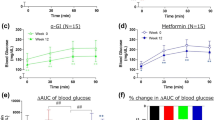Summary
BAYo1248 and BAYm1099 are two new α-glucosidase inhibitors. Postprandial glucose tolerance was significantly improved and post-prandial insulin requirements were significantly reduced as compared to placebo after breakfast and lunch when 20 mg BAYo1248 were administered prior to breakfast and after breakfast, lunch and dinner when 50 mg BAYm1099 were given prior to all three main meals. Postprandial breath H2 concentrations were mildly increased when these α-glucosidase inhibitors were given and no patient complained of any adverse effects (such as flatulence, abdominal pain or diarrhea). BAYo1248 and BAYm1099 might be useful adjuncts to insulin in the treatment of patients with insulin-dependent diabetes mellitus.
Similar content being viewed by others
References
Creutzfeldt W (ed) 1982 First International Symposium on Acarbose. Effects on carbohydrate and fat metabolism. Excerpta Medica, Amsterdam-Oxford-Princeton
Dimitriadis G, Tessari P, Go V, Gerich J (1982) Effects of the disaccharidase inhibitor acarbose on meal and intravenous glucose tolerance in normal man. Metabolism 31 (8):841–843
Dimitriadis G, Gerich J (1983) Importance of timing of preprandial subcutaneous insulin administration in the management of diabetes mellitus. Diabetes Care 6 (4):374–377
Dimitriadis G, Tessari P, Go V, Gerich J (1985) α-Glucosidase inhibition improves postprandial hyperglycemia and decreases insulin requirements in insulin-dependent diabetes mellitus. Metabolism 34 (3):261–265
Gerard J, Luyckx A, Lefebvre P (1981) Improvement of metabolic control in insulin dependent diabetics treated with the α-glucosidase inhibitor acarbose for two months. Diabetologia 21:446–451
Hillebrand I, Boehme K, Graefe K et al. (1984) Effect of two new α-glucosidase inhibitors on postprandial blood glucose and serum insulin levels in normal subjects. Diabetologia 27:284
Jenkins D, Taylor R, Golf D et al. (1981 Scope and specificity of acarbose in slowing carbohydrate absorption in man. Diabetes 30:951–954
Ladas S, Papanikos J, Arapakis G (1982) Lactose malabsorption in Greek adults: correlation of small bowel transit time with the severity of lactose intolerance. Gut 23:968–973
Lembcke B, Kirchhoff S, Fölsch U (1984) Deoxynojirimycin derivatives: new potent competitive inhibitors of small intestinal α-glucosidase. Eur J Clin Invest 14 (2):47
Lembcke B, Fölsch U, Klausgrete E et al. (1984) Desoxynojirimycin-Derivative: Welche Dosierung führt zur Kohlenhydraht-Malabsorption? Akt Endokrin 5:104
McCulloch D, Kurtz A, Tattersall R (1983) A new approach to the treatment of nocturnal hypoglycemia using α-glucosidase inhibition. Diabetes Care 6 (5):483–487
Metz G, Gassull M, Leeds A et al. (1976) A simple method of measuring breath hydrogen in carbohydrate malabsorption by end expiratcry sampling. Clin Sci Mol Med 50:237–240
Puls W, Keup U, Krause H et al. (1982) The concept of glucosidase inhibition and its pharmacological realization. In: Creutzfeldt W (ed) Acarbose: Effects on Carbohydrate and Fat Metabolism. Excerpta Medica, Amsterdam-Oxford-Princeton, pp 16–26
Raptis S, Dimitriadis G, Karaiskos K et al (1980) Long term effects of an α-glucosidase inhibitor on Insulin requirements and catecholamine levels assessed by the artificial b-cell. Diabetes 29 (Suppl. 2):41 A
Sachse G, Willms B (1979) Effects of the α-glucosidase inhibitor acarbose on blood glucose control of sulfonylurea treated diabetics and insulin-treated diabetics. Diabetologia 17:280–290
Saunier B, Kilker R, Tkacz J (1982) Inhibition of N-linked complex oligasaccharide formation by 1-desoxynojirimycin an inhibitor of processing glucosidases. J Biol Chem 257 (23):14155–14166
Schöffling K, Hillebrand I, Berchtold P (1980) Treatment of diabetes mellitus with the glycosidase hydrolase inhibitor Acarbose. Creutzfeldt W (ed): The Enteroinsular Axis, Front Hormone Res, Vol 7, S Karger, Basel, pp 248–257
Schwarz R, Datema R (1984) Inhibitors of timming new tools in glycoprotein research. TIBS 1:32–34
Sokal R, Rohlf J (1981) Biometry. New York, WH Freeman
Tadesse K, Eastwood M (1977) Breath Hydrogen test and smoking. Lancet: 2:91
Walton R, Sherif I, Noy G, Alberti G (1979) Improved metabolic profiles in insulin-treated diabetic patients given an alpha-glucosidase inhibitor. Br Med J 1:220–221
Author information
Authors and Affiliations
Additional information
This work was supported by grants from the Social Ministry, Athens, Greece; Department of Internal Medicine I, University of Ulm, Germany; Deutsche Forschungsgemeinschaft SFB87 Endokrinologie, Ulm, Germany; and the Alexander S. Onassis Foundation, Vaduz Lichtenstein
Presented in part during the 20th Annual Meeting of the EASD in London, 12–15 September, 1984
Rights and permissions
About this article
Cite this article
Dimitriadis, G., Raptis, S., Raptis, A. et al. Effects of two new α-glucosidase inhibitors on glycemic control in patients with insulin-dependent diabetes mellitus. Klin Wochenschr 64, 405–410 (1986). https://doi.org/10.1007/BF01727525
Received:
Accepted:
Issue Date:
DOI: https://doi.org/10.1007/BF01727525




